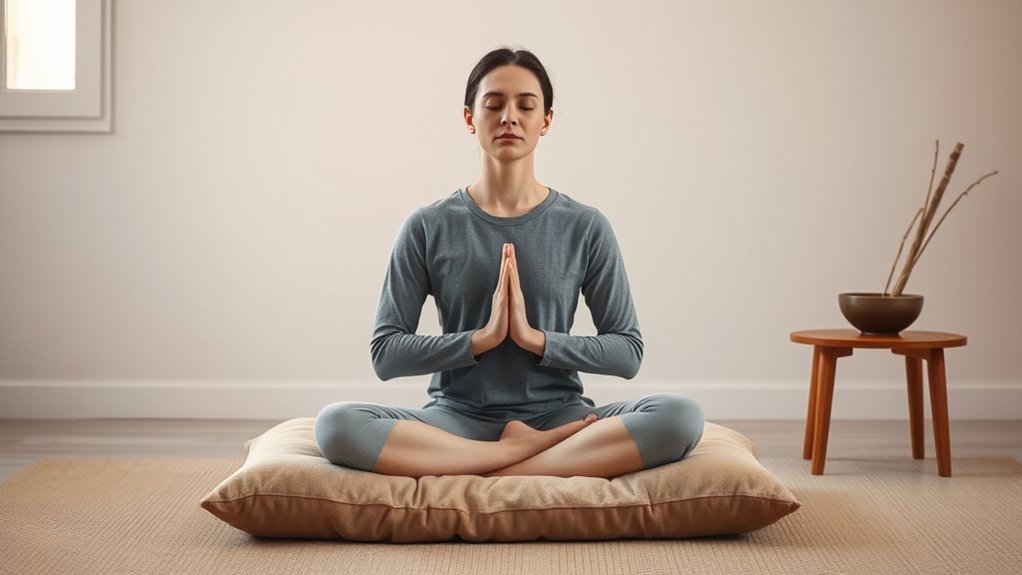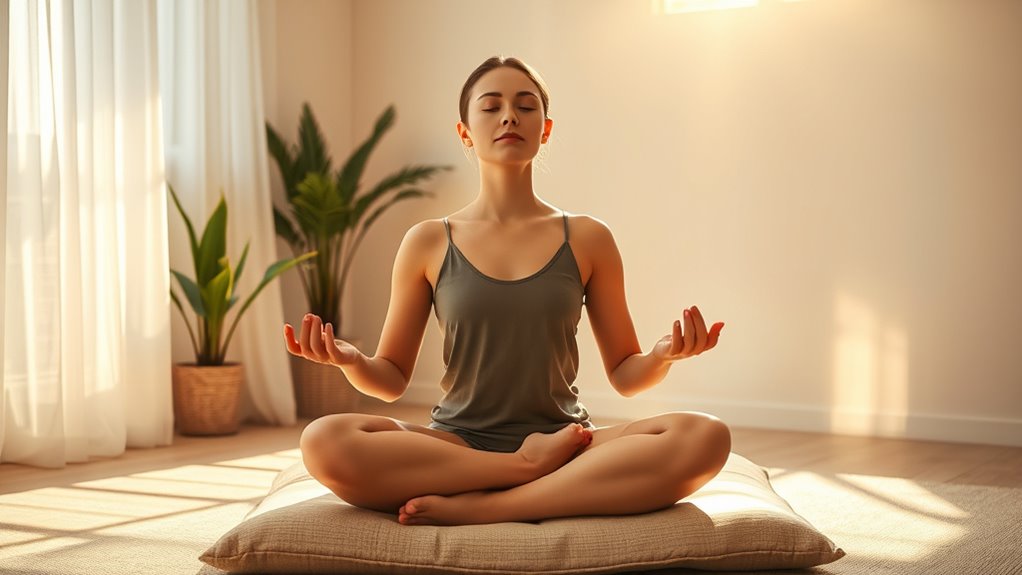Breath‑counting meditation is a simple mindfulness practice where you focus on your natural breathing, counting each inhale as “one” and each exhale as “two” up to ten before starting over. To get started, sit comfortably, keep your back straight, and gently bring your attention to your breath. When your mind wanders, acknowledge the distraction without judgment and softly bring focus back. Continue performers and you’ll discover how this calm, focused habit can bring greater clarity into your daily life.
Key Takeaways
- Find a comfortable seated position, keep your back straight, and rest your hands to prepare for meditation.
- Observe natural breathing, counting each inhale as “one” and each exhale as “two,” up to ten repeatedly.
- Gently redirect focus to breath and restart counting from one whenever the mind wanders or becomes distracted.
- Recognize wandering thoughts without judgment and softly bring attention back to the breath as an anchor.
- Regular practice enhances focus, reduces stress, and cultivates a calm, attentive mindset over time.

Have you ever wondered how to quiet your mind and stay present amidst daily chaos? Breath‑counting meditation offers a simple yet powerful way to do just that. It’s a form of mindfulness technique that helps you anchor your attention to your breath, fostering a sense of calm and clarity. When you practice breath‑counting meditation regularly, you’ll notice the meditation benefits extend beyond your quiet moments, helping you manage stress and improve focus throughout your day.
To start, find a comfortable seated position where you won’t be disturbed. Keep your back straight but relaxed, and rest your hands on your lap or knees. Close your eyes if that feels comfortable, or soften your gaze and look downward. Begin by taking a few slow, deep breaths to settle into your body. Once you’re ready, shift your focus to your natural breathing—do not try to control it, just observe it. The key here is to use your breath as an anchor for your attention.
Find a comfortable seat, relax your body, and gently observe your natural breath as an anchor for mindfulness.
As you breathe naturally, start counting each inhale and exhale silently in your mind. When you inhale, think “one,” and when you exhale, think “two,” and so on up to ten. After reaching ten, start over at one. If your mind drifts away to thoughts, worries, or distractions, gently bring your focus back to your breath and restart the counting from one. This process trains your mind to stay present, which is central to mindfulness techniques. Incorporating awareness of your antioxidant-rich juices can further enhance your understanding of how natural elements support mental clarity and overall well-being.
Practicing breath‑counting meditation for just a few minutes each day can yield significant meditation benefits. It improves your ability to stay attentive and reduces mental chatter that often leads to stress. Over time, you’ll find it easier to recognize when your mind wanders and gently guide it back without judgment. This non-judgmental awareness is what makes mindfulness techniques so effective in cultivating a calmer, more centered state of mind.
Frequently Asked Questions
Can Breath-Counting Meditation Help Reduce Anxiety Instantly?
Breath-counting meditation can help reduce anxiety quickly by promoting mindfulness enhancement and focus improvement. As you focus on counting your breaths, you divert attention from stressful thoughts, calming your mind. This practice encourages present-moment awareness, which can lessen feelings of anxiety instantly. Though effects vary, many find that even short sessions help create a sense of calm and clarity, making it a useful tool for immediate relief.
How Long Should Beginners Practice Breath-Counting Meditation Daily?
Did you know that practicing meditation just 10 minutes daily can substantially reduce stress? For beginners, it’s best to follow duration guidelines of starting with 5-10 minutes each day. Consistency is key; practicing regularly helps your brain adapt and enhances benefits. As you progress, you can gradually increase your session length. Stick with a routine, and you’ll build a sustainable habit that improves your mental well-being over time.
Is Breath-Counting Meditation Suitable for Children or Seniors?
Breath-counting meditation can be suitable for children and seniors when you use child-friendly techniques and senior adaptation tips. For kids, simplify instructions and make sessions short and engaging, while seniors benefit from gentle guidance and a comfortable environment. You should observe their responses and adjust accordingly, ensuring the practice remains accessible and enjoyable. With these adaptations, breath-counting meditation becomes an effective tool for all ages to promote relaxation and mindfulness.
What Common Mistakes Should I Avoid During Practice?
Ever wonder what mistakes might throw off your meditation? You should avoid distraction management issues by staying focused on your breath, not letting your mind wander. Equally important is maintaining proper posture, as slouching can hinder your practice. Do you realize how easily you can lose concentration? Keep your environment quiet and sit upright to maximize benefits and prevent common pitfalls during breath-counting meditation.
How Does Breath-Counting Compare to Other Meditation Techniques?
You might notice breath-counting offers a unique approach compared to other meditation techniques. Its focus on mindfulness consistency helps you stay present, while its technique versatility allows you to adapt it easily to different settings. Unlike some methods that require complex postures or mantras, breath-counting keeps things simple and accessible. It’s a practical way to develop concentration and calmness, making it a valuable option in your meditation toolkit.
Conclusion
As you close your eyes and settle into each breath, let the rhythm become your anchor, guiding you through the quiet sea of your mind. With every count, you weave a gentle thread of calm, turning chaos into a peaceful melody. Remember, this practice is your steady compass—trust it to lead you home, one breath at a time. Embrace the stillness, and let your mind drift like a leaf on a tranquil stream.









